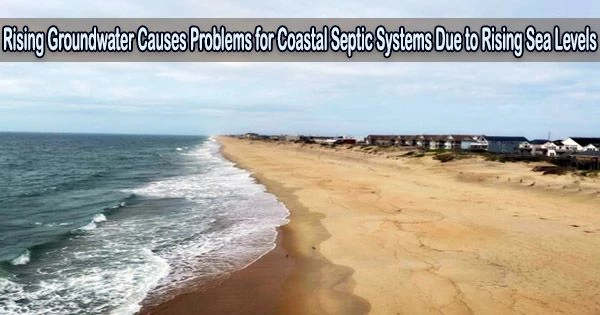Coastal communities are being severely impacted by sea level rise and powerful storms, which result in more floods, more land being lost to saltwater intrusion, more wetland loss/change, and effects on local infrastructure.
Septic systems, often known as individual, onsite wastewater treatment systems, are common in coastal communities. About a million septic-equipped homes, either on the coast or in watersheds that empty into the sea, are located in North Carolina alone.
Coastal septic systems need unsaturated soils to filter effluent and direct flow away from homes in order to function properly. However, the shallow groundwater table is rising in some areas, putting homes in a precarious situation.
“Typically, when you permit the septic systems in North Carolina, they want to have about one and a half feet of unsaturated soils below the system,” explains Michael O’Driscoll , associate professor at East Carolina University. O’Driscoll is a coauthor of a new study being presented at the Geological Society of America’s annual meeting tomorrow.
Septic systems, however, are no longer operating as intended in some of these regions due to rising groundwater levels.
“You can have a mixture of groundwater and untreated waste getting up to the surface,” says O’Driscoll. While unpleasant, it can also be a health hazard, as the normal filtration of bacteria and viruses doesn’t happen.
When you look at sea level rise along the Atlantic coast, that part of Northeastern North Carolina and Southern Virginia around the Chesapeake Bay, have some of the highest rates of sea level rise. Some of the town officials noticed that they’re having more challenges with groundwater-related flooding and stormwater issues.
Professor Michael O’Driscoll
This water can back up into homes, compounding the situation and creating a significant concern for locals. Some locals had to wait days or even weeks for the water to go down before they could utilize their septic system.
As part of the larger North Carolina Sea Grant research effort, O’Driscoll and colleagues focused on understanding rising groundwater levels in coastal areas. “We wanted to get an idea of where the more risky areas are, to help understand and try to come up with some solutions for how to adapt to this change,” he says.
The team focused on the town of Nags Head, a popular tourist destination in Dare County, North Carolina.
“When you look at sea level rise along the Atlantic coast, that part of Northeastern North Carolina and Southern Virginia around the Chesapeake Bay, have some of the highest rates of sea level rise,” says O’Driscoll. “Some of the town officials noticed that they’re having more challenges with groundwater-related flooding and stormwater issues.”
Eight aquifer wells operated by the NC Department of Environmental Quality have been monitoring the area’s groundwater levels since 1983. In order to study how groundwater changes affected septic systems, the researchers also installed instrumentation on five additional wells in addition to these state-operated wells.
They found that groundwater levels are rising with the sea level rise. The thickness of unsaturated soil required for functional septic systems has decreased as a result of this development.
The team discovered that homes in the Nags Head region that were less than about 2.6 meters above sea level were more likely to experience insufficient unsaturated soils and would probably experience problems with on-site water treatment systems. They did this by examining the land surface elevations of septic systems and groundwater levels.
“Considering state regulations require 45 cm of unsaturated soils for septic systems to work as designed, having groundwater levels withing a meter of the land surface means problems,” says O’Driscoll.
“The systems that are in the lower elevation areas, they’re having problems right now,” he says. During their study, one home they were monitoring had groundwater in the drain field about 70% of the time. “That tells you there’s no treatment… and it can just get worse over time.”
“To combat dysfunctional onsite wastewater systems,” O’Driscoll says some builders are creating an artificial buffer. They put septic systems in mounded sand, effectively raising the drain field and adding unsaturated soils.” In some communities, like Nags Head, officials have created their own septic health initiatives to identify problem areas and deal with failing systems that need to be replaced.
O’Driscoll notes that big municipal wastewater treatment facilities are cost prohibitive for some communities. He says that if there is an area where there’s a hotspot of failing systems, an advanced treatment system called a package plant might be an option for a community. They cost more than a septic tank, but a lot less than constructing a municipal wastewater treatment facility.
According to the team’s research, coastal communities need updated septic system laws. The researchers found that the possible ever-rising groundwater levels were not taken into account by the laws already in place for septic systems.
O’Driscoll says that “new regulations have to consider a longer-term approach more related to the life-span of a home.”
















